At FCC, Broadband Access Is Chief Issue
You can check phone messages on your television, watch a movie on your cellphone and soon use one phone that works over land lines at home, cellphone networks on the road and Wi-Fi hotspots at coffee shops.
“The changes that are occurring in telecommunications today are affecting every aspect of the way people are interacting,” said Kevin J. Martin, who took over last March as chairman of the Federal Communications Commission.
For Martin, 39, the key to delivering the future of telecommunications is a high-speed, or broadband, network available to everyone. Getting affordable broadband service to every household must be the commission’s top priority, Martin said in an interview with The Times.
There are political differences over how to reach that goal, but the Republican chairman has forged a working relationship with the FCC’s two Democrats. That has helped lead to unanimous approvals of three telephone mega-mergers, rules requiring broadband phone companies such as Vonage Holdings Corp. to provide emergency 911 service and other difficult issues.
Getting bipartisan support “in and of itself, I think, is a significant accomplishment,” he said. It’s also necessary: The agency has been short one member, leaving it with two Republicans and two Democrats.
The Martin-led FCC has removed rules requiring the nation’s phone companies to share high-speed lines with competitors, creating a more level playing field with cable TV’s high-speed service. It also has adopted a resolution stating that broadband customers have the right to gain access to the Internet and use any information or applications they want.
Martin talked with The Times about a wide variety of issues facing the commission.
*
Question: On complaints about indecency on TV, are you satisfied with the cable industry’s plans to develop family-friendly program packages?
Answer: Several companies are looking at providing these family tiers, and I’m anxious to see the details of their proposals. I’ve said for several years that I think consumers are increasingly concerned about some of the content that’s on television.
*
Q: Is the a la carte model -- letting customers pay for the channels they want -- a goal you want the industry to reach?
A: I think the goal was to give parents some additional tools to control that content that’s coming into their homes. A la carte is one option that I’ve talked about, and there are others. My goal is to make sure the concerns of parents get addressed, and I’ve always thought there’s a variety of ways that we could end up doing that.
*
Q: Is a solution to the indecency issue one of the conditions to approving the deal that Comcast Corp. and Time Warner Inc. have to buy and split up bankrupt Adelphia Communications Corp.?
A: The commission staff is really just getting into some of the details on that specific transaction, and I don’t know all of the issues that parties may have raised in the proceeding.
*
Q: You and others have questioned the legal authority of the FCC to act on indecency issues in cable and satellite. But you don’t hesitate to impose them in a merger situation.
A: I will say that in transactions that have been before us in the past, the commission certainly imposed conditions that related to potential harms that were identified, and those conditions involved something beyond what merely our rules required.
*
Q: When do you expect fines to be levied in the existing backlog of indecency complaints?
A: I’m hopeful that we’ll be able to get something out within the next month.
*
Q: On telecom reform, are we where the Telecommunications Act of 1996 expected us to be?
A: The 1996 act was certainly premised on providing an environment in which multiple providers can come in and try to compete with each other for telecommunications and media services. And I think we are seeing that kind of competition most directly in things like high-speed Internet access, where you’ve got cable and telephone companies competing. Wireless is another area.
*
Q: Most consumers have two high-speed pipes -- DSL and cable modem -- available to them at home, but other technologies are not ready yet for the mass market. What is the FCC doing in the meantime to ensure competition?
A: Things like broadband over power lines could be deployed much more rapidly if it ends up being a more promising technology. Wireless broadband already is being pretty ubiquitously deployed. We’re going to continue to make progress on that. But ... all of these new technologies are competing to acquire customers. So even between the cable companies and the telephone companies, we’ve seen dramatic decreases in prices, increases in speed and more ubiquitous deployment.
*
Q: So are you saying that two pipes aren’t enough?
A: Yes. In the long run, we’ve got to make sure that there are additional competitors as well. But I think that we’re very fortunate that we’ve actually got two pipes into the homes that are competing today.
*
Q: AT&T; Chairman Edward E. Whitacre Jr. said recently that Google Inc., Vonage Holdings Corp. and other Internet companies were “nuts” if they thought they could use his broadband pipes for free. Is this the opening salvo in a battle to control the content going over a carrier’s network?
A: The commission has been uniform in its support of making sure consumers are still going to have access to all the content and information the Internet provides.... On the other hand, I think that the commission shouldn’t be adopting regulations in anticipation of problems that we haven’t seen materialize. ... In the marketplace today, there is very little evidence of any kind of blocking of consumer access.
*
Q: On media ownership, the FCC allowed media companies much wider latitude, for instance, in buying other outlets in the same cities. A court rejected much of the rules. Congress objected, and the public howled. It’s back to the FCC now. How are you going to tackle this one?
A: The commission is required under the 1996 act to periodically review its ownership rules and adjust them to the extent that technology has changed and there are new entrants in the media field. Certainly, since some of these rules were adopted, there have been significant changes in that there’s been an increasing number of people providing access to content.
For example, the prohibition on companies being able to own a newspaper and a radio station in the same market was put in place prior to widespread deployment of cable television, prior to the deployment of Internet infrastructure and the development of Internet content.
*
Q: But the U.S. 3rd Circuit Court of Appeals didn’t like a number of the rules, including one that increased the number of media properties a company could own in one market.
A: The 3rd Circuit said the commission hadn’t justified enough of the changes it made. So what the commission is going to need to do is go through a proceeding to change some of the rules, but do so in a way that hopefully addresses the concerns of the 3rd Circuit a little more directly.
The decision actually upheld, for example, the commission’s removal of the prohibition on newspapers owning broadcast properties. It said the commission was right, the landscape had changed significantly. But it didn’t think that our new rule of how much you could own was appropriate. So we’re going to have to find what the right balance is.
*
Q: When you look at all the technology we have now and all that is coming soon, what kind of a landscape do you expect to see in five years?
A: I think we’re going to see quite dramatic changes, but what’s critical for all of those changes is increasing connections, increasing connection speeds and making sure it’s ubiquitously and affordably done for everyone in the country. And increasingly that it’s even done wirelessly.



